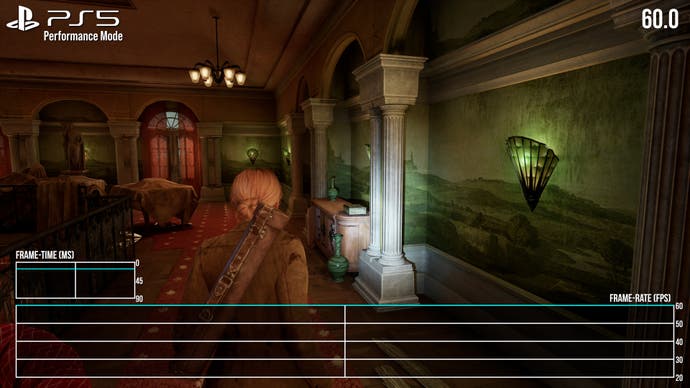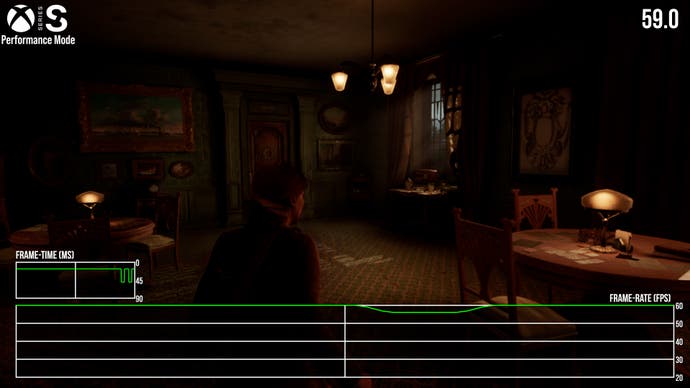Letting you loose on the Derceto Manor once more, Alone in the Dark is a modern re-imagining of the 1992 survival horror classic from Infogrames, widely considered to be the first ever 3D survival horror game and something of a precursor to Capcom’s Resident Evil series, which debuted later in 1996. It’s easy to count the similarities: the 2D pre-rendered backdrops overlaid with 3D polygonal models, a choice of two characters, tank controls, plus a mixture of puzzle-solving and combat. Pioneering in its day with its cartoonishly exaggerated character models, it still has an eerie charm, even today.
Flash forward 32 years and a lot has changed in the standards of modern game design. This new 2024 release of Alone in the Dark is built on Unreal Engine 4. It also takes a point from the Resident Evil 2 and 3 remakes in moving away from static pre-rendered backdrops in favour of fully 3D environments. It’s a big change, but a well-executed one from developer Pieces Interactive. Every inch of the estate is now beautifully detailed: the third-person camera lets you take in the brushstrokes on every portrait, every decaying ornament – all flanked by shadows from your clip-on flashlight.
It gives us a modern take on its action, with plenty in the way of weapons to dispatch its nightmarish creatures. Crucially, the focus on puzzle-solving is still in keeping with the spirit of the 1992 original. You’ll navigate the mansion for cryptic clues, you’ll scour chests for keys to doors, or pieces of puzzles that need to be re-arranged. It’s all hugely satisfying once you figure it out – and all of this is built to spec for current-gen PlayStation 5, Xbox Series X and S consoles, plus PC.
There are some major visual high points here, but also some technical issues worth addressing. Models are nicely detailed to start, with stars Jodie Comer and David Harbour providing their likeness for the leads. It even goes as far as using subsurface scattering for skin, with every freckle and mole scanned into the in-game renders. The environments, too, are densely littered with detail. Every room is distinctly themed: the rocking horses, swaying curtains, abandoned dolls, so many elements are interactive with physics-based properties. There’s even volumetric lighting, plus light shafts streaking through balconies windows.
There’s also a form of baked GI, where select rooms emit a vivid hue of green, red or blue – mimicking the eerie lighting of Dario Argento films. And lastly there are the nightmare sequences: at select points, you’ll abruptly enter an alternate reality, one that’s in ruin, set ablaze, or overrun with decay. Insects scuttle across its walls, rats scurry underfoot – and otherworldly creatures launch at you in a frenzy. There’s a lot of great visual design going into the manor then. Additionally, as a fun Easter egg, the extras section even lets you switch to the original 1992 Alone in the Dark models.
Sadly, there are some rough spots, bugs, and even stability issues right now. Point number one is that the camera struggles while aiming in confined spaces – which is often, given that so much of the game is set in the manor. Combat really suffers, especially in trying to spot the prompt to pick up an object. Next, there are asset streaming issues. Running at pace through the manor, you’ll spot a white flash artefact across upcoming textures around each bend. It’s a distraction common to some Unreal Engine titles, with detail occluded by walls not rendering quickly enough and so it is here.
On top of that, there are low quality effects too, with the blood splatter from enemies looking especially poor. It’s low resolution, as are the fire alpha effects on throwing a molotov cocktail. You’d expect a lot more from a PS5 or Series X title here. Lastly, and perhaps most urgent of all, I experienced a software crash about two to three hours into the adventure on Series S. It’s good that the game autosaves regularly – but many of these points do need addressing.
PS5 and Series X deliver many of these highs and lows in equal measure, though Series S has a set of other drawbacks in visual settings. The good news, at least, is that all three consoles get a matching couple of modes. One for 60fps performance, the other being a 30fps quality mode that prioritises resolution. Taking PS5 for example, the resolution difference is really the only one of note – and all other settings stay in place regardless of selection.
There’s native 4K on PS5 and Series X quality modes, which is a great start. Typically it’s at the full 3840×2160, though rare moments drop to 1836p in taxing cutscenes. On Series S though, we’re typically at 900p, with no noted res drops under. The result, inevitably, is that the image is blurrier on Series S, while fine sub-pixel detail like facial hair is also lost in the upscale from 900p. PS5 and Series X are identical in settings as you might expect: in textures, shadows and beyond – though the Series S has a few other notable quality reductions.
The main point is that textures drop in quality. On character faces, clothing, or the paintings strewn across the manor, most run with lower definition assets – which isn’t flattering viewed up close. Ambient occlusion shading is also degraded on Series S, as are volumetric effects. In general though, it’s the texture quality and 900p resolution that stick out most. Also frustratingly, all HUD elements – icons, text and so on – run at 1080p on Series S, creating a rough, aliased result.
On the surface, the quality mode looks like a respectable 4K experience on PS5 and Series X at least. Turning to the frame-rate testing though, it quickly reveals a big issue: inconsistent frame pacing at 30fps. There isn’t any way to disguise this fact: performance is often locked at 30fps, but judder is abundant anyway. Frame-times jump between 16, 33 and 50ms and that goes for PS5, Series X and S in equal measure. No machine gets away unscathed.
I suppose the silver lining is that the frame-rate is mostly locked at 30fps, so in that sense it is well optimised. However, the end experience just doesn’t feel pleasant in motion. On the upside, all consoles offer a motion blur toggle, ranging from off to low, medium, high and ultra. It might help smooth the lateral motion a little, but again, it’s hard to disguise the judder on quick pans. As a 30fps mode, it’s hard to recommend, especially when there’s a 60fps performance mode one menu selection away.
Jumping to the performance mode, the outlook is more positive with 60fps in view most of the time, whether it’s exploring, puzzle solving or combat itself. Generally anyway. In terms of resolution, it shifts to a dynamic setup, between 1080p and 4K. Typically, you’re looking at figures like 1440p for most gameplay, where all sub-4K frames are reconstructed with what is likely AMD’s FSR2 in this case. The final image still looks decent most of the time, though flashes of the base, raw pixel count are obvious in quick movement. And unfortunately, again, fine details like hair, beards, tend to struggle in the upscale.
As for as the frame-rate itself, PS5’s reading is often solid at 60fps, though expect single frame drops, and even occasional hitches in moving between areas. Notably, there’s a streaming hiccup in a particular outdoors segment, always in the exact same spot, which is a little jarring. As for sustained drops, fire effects around enemies at times take us down to the 45fps line in the marshland of chapter two. Plus, several cutscenes push the machine well into the 40s. It’s not a perfect return on PS5 but outside of these moments, the manor itself is usually optimised for 60fps at least.
Switching to Xbox Series X on its performance mode, we’re again faced with a dynamic 1080p to 4K range. Image clarity is in the same place as PS5 on average. There’s a decent lock at 60fps mostly here too, except rapid movement is more of an issue on Series X. It seems that streaming assets between areas of the manor produces more hitches and frame-rate dips overall, at least based on the first three hours. In effect this manifests as larger clusters of dropped frames on Series X, just as we approach any new room. This only adds to the existing cases of hitching – in the marshland outdoors – that we see on PS5. It’s an extra distraction the game doesn’t really need, but mostly it is in the right place at 60fps.

The major outliers are in effects-heavy combat, and similar to PS5, the collision of heavy fire alpha transparencies and enemies takes us into the low 50s, or high 40s. On the whole I’d still recommend using the performance mode on both premium consoles, but do go in expecting some frame-rate nose-dives in very specific scenarios, and occasional hitches at points too.
Last up is Series S in its performance mode. In terms of resolution this is striving for 900p at best, with a lower bounds of 800×450. And in a bid to keep 60fps in check – which to its credit, it does most of the time – the typical resolution often falls in between those figures, at 684p. This is in no way flattering to the world design, let’s be honest. Even in the best case at 900p it’s a blurry image on Series S, but at 450p there’s serious break-up, flicker and visual noise on any movement. Any camera cut also reveals a very clear, low base resolution. Sadly, this is the sacrifice, along with the lower texture resolution, to get to 60fps.
The benefit is that the frame-rate is actually very much on par with Xbox Series X. Most areas flow at 60, albeit with similar blips and hitches to Series X along the way. It’s also a surprise to find that I could not get any major sustained drops in combat, try as I might, though cutscenes do still suffer from a drop. There is potential for GPU load to stack up, in other words, even when the resolution hits a low point of 450p. Series S is playable at 60fps otherwise; just be warned that the cost to image quality is dear, and it does not avoid the odd streaming hitch.

That’s the state of Alone of the Dark on console. Above all else, the game’s quality is centred around its puzzles, and for that alone it’s worth persevering for. The unfortunate lack of polish doesn’t quite diminish its appeal. I found genuine joy in decoding some of the devious clues laid out in each room. It’s like a callback to the cryptic style of puzzle-solving in the Broken Sword series, or even Little Big Adventure on PC.
However, in this case, the stability issues, the camera controls in combat, and odd effects do need some work. It’s not far off the mark on PS5 and Series X, but frankly, the state of the Series S version’s image quality at 60fps is unfortunate. The ideal experience is really at 60fps and the sacrifice to get there is a steep one for the 4TF console. Still, as a reprisal of such a milestone game, Alone in the Dark has a surprising hook to it. It has a great atmosphere, driven by meticulous detailing across the manor, if you’re able to accept the technical rough points that go with it.

Laura Adams is a tech enthusiast residing in the UK. Her articles cover the latest technological innovations, from AI to consumer gadgets, providing readers with a glimpse into the future of technology.








